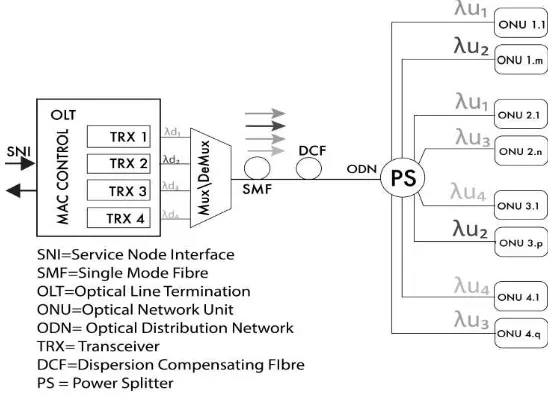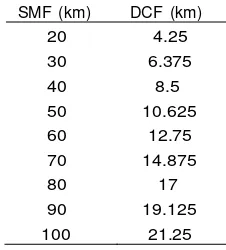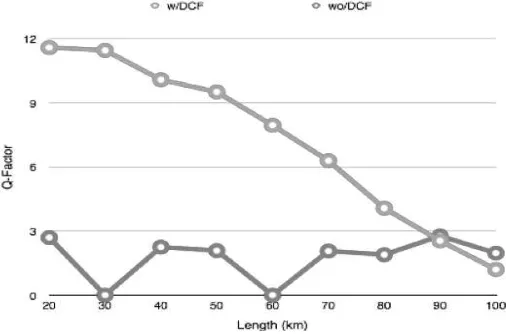DOI: 10.12928/TELKOMNIKA.v15i1.3660 165
1,2Telekomunikasi Street Buah Batu Bandung 40257 Indonesia (+6222)7564108
Corresponding author, e-mail: [email protected], [email protected]
Abstract
Next Generation Passive Optical Network Stage 2 (NG-PON2) have to resolve the problem like demand each user, for example, HDTV, 3DTV, Hologram and Telemedicine. The research designed Passive Optical Network (PON), which is meet requirements of NG-PON2. Using stacked 4 Optical Line Terminal (OLT) with an aggregate 40 Gbps transmitted on fiber Single Mode Fiber (SMF) and Dispersion Compensation Fiber (DCF) by comparing the system without DCF cable. On the condition of minimum standards, the range of 40 km with a power splitter 1:64 only 9:01% power difference while the increased in the Q factor of 65.5%. With these results, it can be said that systems using DCF can be used optimally. In addition, with the power splitter 1: 4 and a lower power worth 0 dBm can produce a range of 150% further. With the same distance as far as 40 km, this research increasing power splitter 6 times increase compared with previous research.
Keywords: next generation passive optical network stage 2, time wavelength division multiplexing, optical fiber cable, dispersion compensation fiber
Copyright © 2017 Universitas Ahmad Dahlan. All rights reserved.
1. Introduction
The evolution of access networks in optical technology has been studied in the literature. Accompanied by increased capacity of the people to meet the needs, two major organizations make PON technology standard that International Telecommunications Union - Telecommunication Standardization Sector (ITU-T) and Institute of Electrical and Electronics Engineers (IEEE). Sub of the PON is Broadband-PON (BPON) and Ethernet-PON (E-PON), for gigabit class G-PON and G-EPON, class 10-Gb or NG-PON Stage 1 is XG-PON and 10G-EPON. All the above standard using point to multipoint with splitter and using mechanisms Time Division Multiplexing (TDM)/Time Division Multiple Access (TDMA).
The following roadmap of PON, Full Service Access Network (FSAN) start of investigating of optical technology in an access network with more than 10 Gbps bitrates in early 2010. The project is called NG-PON2. With a variety of technologies candidates prepared to consider the election,in April 2012 began the research for specification NG-PON2 with technology of wavelength division multiplexing (TWDM), and it can be approached from point to point WDM algorithm. Development of specifications that belong to the area of responsibility of ITU-T, the expert group formed by study Group Q2 15. The recommendation of ITU-T G.989.1 produced the standard of 40 Gbps passive optical network that was issued in March 2013. First layer of NG-PON2 is physical media dependent (PMD) with G.989.2. Secound issue is completed by layer of the transmission convergence (TC), G.989.3 which was launched in November 2015.
Based on [2] is discussed convergence layer, this research also purposed to a wider range of researchers who are active in the area of optical communications. One of author
ECOC’2015 and ITU-T standard for NG-PON2 in November 2015, has analyzed that TC OLT
with TWDM to be one of concern for research. This paper help researchers to take TWDM more reasonable.
The activity of the research is focusing on the NG-PON2 technology which can cope with future bandwidth requirements with the slogan pay as you grow [3]. NG-PON2 has been stan- dardized by the ITU-T G.989 standard and one of the architectural differences with the previous generation is the use of architecture Time Wavelength Division Multiplexing (TWDM). TWDM-PON is a cost-effective solution for primary and NG-PON2 [4].
The studied about tunable wavelength on Optical Network Unit (ONU) has been released by [5]. Wavelength with 100 Ghz channel spacing in the C-Band is chosen. Line rate with 2.5 Gbps for residential service or 10 Gbps for business services is analyzed for (ONU) is Heater-integrated TFF+PD with tuning time is s order.
The research [6] have demonstrated transceiver EML with SOA technologies for NG- PON2 with high power output <+ 6 dBm in 40 km transmission. The advantages Transmitter on EML (External Modulated Lasers) lies in the stability of the Mach-Zender modulator output when compared with DML (Direct Modulated Lasers). However, in terms of power output, DML has advantages compared to EML.
Besides the development of NG-PON2 with a bit rate of 40 Gbps, the research has been done up to 50 Gbps through the Non-Return to Zero(NRZ) On-Off Keying (OOK) [7]. The sig- nal modulation arrangement is a key issue for 40 Gbps Dense Wavelength Division Multiplexing (DWDM) fiber optical communication framework , which decides transmission quality and ghostly effectiveness. The results of [8] demonstrated that DRZ code has better transmission execution, are reasonable for long or center separation transmission, take care of the demand of business application. This paper [9] mostly does research and examination on against dispersive execution and hostile to nonlinear execution for intensity modulation, for example, NRZ, RZ, CS-RZ, DRZ, MD-RZ in 40 Gbps fast single-channel optical transmission framework. CSRZ code has higher ghostly productivity, higher scattering resistance, and nonlinear resilience than RZ code, making it more appropriate for long distance transmission.
The last paper that discussed cross talk for NG-PON2 is written by [10]. Their analysis about crosstalk for higher number customers and wavelength with range number channel 4 until 32, power splitter starts from 1:64 to 1:1024. The final result showed that using AWG channels can handle about 32 channel. In addition with different split ratio and with leveling method, accounting in this specific case for up to 19 dB.
The problem on fiber optic technology have limitations on the activities of the asymmetric optical medium. In a modern fiber optic technology, there are four issues, namely the Optical Signal to Noise Ratio (OSNR), non-linear effects, dispersion, and Polarization Mode Dispersion (PMD). Problems in OSNR can be strengthened by the addition of an amplifier [11, 12], whereas non-linear overcome by designing the light intensity to the type of optical media [13, 14]. Dispersion problems have been studied by many researchers, such as the [15] using delay interferometer by utilizing a Mach-Zender at OLT. In contrast to the PMD, the effects of inhibiting the increase in speed on bitrate if above 10 Gbps and its countermeasures are relatively expensive [16].
Several papers have not yet discussed the dispersion of the NG-PON2. This research has examined from different sides and offers one of the methods for compensation. In this research, selection DML as transmitter output power to keep down the appropriate reference of energy saving. Lack of DML in dispersion problems would be overcome with usage a novelty of combination SMF and DCF. In addition, the study has compared the value of the Q-factor of the power receiver as a performance parameter.
approach was first emitted. Moreover, it has studied the combination of the distance between cables DCF and SMF to produce a dispersion value approaches zero, also comparing the various power splitter on the cable systems that add DCF for scalability purposes.
This paper is divided into five main sections. First, the introduction discusses the back- ground of the problems of NG-PON2, and explain the sections of paper simply and convey the contributions that resulted from this research. Second, previous work discusses research related to paper. In addition, written with the homely purpose of each of these studies. Third, Architecture Design is to describe the parameters and forms designed networking. Fourth, Result and Analysis, related to the calculation and simulation in the scope and scalability. Fifth, Conclusion is a summary of the results of research that has been done
2. Research Method
The proposed of this architecture uses four wavelengths are stacked to increase capacity to 40 Gbps bit rate. By using several OLT 10 Gbps are stacked, one of the future goals with energy and cost saving will be achieved. The ISP does not need to buy 40 Gbps module. This can be overcome by 10 Gbps OLT stacked with TWDM.
Figure 1. Architecture and Design System
Figure 1 shows the architecture of Time Wavelength Division Multiplexing (TWDM), the structure of the downstream uses DWDM channel spacing is 0.8 nm. The reason for using DWDM because it has a narrow frequency spacing and has become a standard GPON. Wavelength band for upstream (US) are allocated to 1524-1544 nm and for downstream (DS) are 1550-1552 nm with the number of the wavelength of four. Transceiver system use Direct Modulated Laser (DML) which of the electrical bits are modulated into an optical signal without using the external modulator (e.g. Mach-Zender).
The performance degradation due to dispersion problems can be overcome by combining two optical cables. First, as the main fiber, using the Single Mode Fiber (SMF). Second, Dispersion Compensating Fiber (DCF), which aims to balance the dispersion occurs. By knowing the SMF and DCF specifications, we are able to determine the value of each fiber.
Table 1. Combination between Length of the Cable SMF and DCF
The analysis of system performance is based on the value of the Q-factor. One of the reasons Q-Factor compared with a BER (Bit Error Rate) because the Q-factor is high (more than 40), the BER will show the value 0 (zero), the study will be difficult because the trend line will not be optimal. ONU/OLT otherwise successfully transmitted, when the value of the Q-factor 6 where the equivalence of the BER = 10−9 ( reference BER for Optical Network [17] ).Q-Factor is calculated by the variation range from 20 km to 100 km and a power splitter from 1: 4 to 1: 128. For comparison, the system was simulated and calculated without adding DCF cable.
3.1. The Combination Fiber as Long-Reach PON
By modeling using eight wavelengths (four for the downstream and four for upstream), a lot of factors limit the transmission performance as nonlinear effects, dispersion, loss cables, and devices. Problems nonlinear effects negligible because of a relatively small number of wavelengths. Power budget problems can be overcome by increased power transmit or additional amplifier. However, in contrast with the dispersion, no enhancements except accuracy in calculating the distance fiber.
Table 2. Comparison of Power Receive
Power Receiver (dBm)
Splitter 1:4 Splitter 1:8 Splitter 1:16 Splitter 1:32 Splitter 1:64 Splitter 1:128 SMF
Table 3. Comparison of Q-Factor Values
Q-Factor
Splitter 1:4 Splitter 1:8 Splitter 1:16 Splitter 1:32 Splitter 1:64 Splitter 1:128 SMF(km) w/DCF wo/DCF w/DCF wo/DCF w/DCF wo/DCF w/DCF wo/DCF w/DCF wo/DCF w/DCF wo/DCF
20 11.78 2.71 11.77 2.71 11.76 2.7 11.71 2.7 11.59 2.696 11.43 2.68
30 11.8 0 11.81 0 11.78 0 10.44 0 11.46 0 11.07 0
40 10.54 2.24 10.54 2.23 10.5 2.23 10.42 2.23 10.08 2.473 9.36 2.16 50 10.56 2.15 9.41 2.15 10.45 2.14 10.22 2.12 9.51 2.082 8.03 2.02
60 9.87 0 9.82 0 9.64 0 9.15 0 7.95 0 5.87 0
70 9.9 2.17 9.78 2.16 9.35 2.15 8.29 2.11 6.29 2.065 3.89 1.973
80 9.51 1.92 9.19 1.92 8.31 1.91 6.51 1.944 4.07 1.89 1.798 0
90 8.84 2.46 8.13 2.49 6.58 2.51 4.4 2.605 2.54 2.77 0 1.935
100 7.6 2.14 7.2 2.15 4.8 2.12 2.37 1.96 0 1.965 0 0
Table 3 clearly states the value of the Q-factor on the system without DCF, none of which reached a value of 6. In addition, if we look more closely at any of the power received (at least -25 dBm) Q-factor is relatively stable regardless of the number of a splitter. Figure 2 determines the value of Q-factor at the 1:64 splitter systems that uses cables and cordless DCF. Comparison at 1:64 splitters been selected for the minimum standard set bitrate NG-PON2 is 64 for 40 Gbps.
Figure 2. Comparison System using DCF and without DCF
Figure 2 show the fibers that are added DCF has a better performance. It was due to pulse dispersion causes different velocity, the pulse carries a bit faster or slower causes an error in the detection bit. Should be noted that the cable-DCF not eliminate dispersion, but make almost stable pulse velocity to the receiver.
3.2. Power for High Scalability
Technology TWDM network NG-PON2, besides having a high speed and scalability, also apply conservation of energy saving [4]. In addition, NG-PON2 standard with a bit rate of 40 Gbps in ITU-T G.989 states that the minimum distance may transmit as far as 20 km and a power splitter 1:64 [18].
Figure 3. Comparison with Various Power Splitters using DCF Cable
If this research compared with one of studied about NG-PON2 using TWDM and bitrate 40 Gbps symmetric, this research has a few escalations in reach of fiber. Increasing reach about 150 % has been proven, for splitter 1:4 the research High Output OLT/ONU Transceivers for 40 Gbps Symmetric-Rate NG-PON2 Systems only 40 km while this research can do better with 100 km. In addition, with fiber as long as 40 km, this research can be implemented with splitter 1:128.
4. Conclusion
In this paper, TWDM network performance for NG-PON2 has been calculated and com- pared with the fiber without using DCF. The advantages DCF is on restoring stability pulse velocity variations. In addition, with the power splitter 1:4 and a lower power worth 0 dBm can produce a reach of 150 % further while another research need 6 dBm.
For further research, researchers can make comparisons and simulations on technology NG-PON2 by combining several other fibers such as Single Mode Fiber (SMF), DCF (Dispersion Compensation Fiber), True Wave fiber (TW), True Wave-Reduced (TW-RS ), Large Effective Area fiber (LEAF) and Non-Zero Dispersion-shifted fiber (NZDSF). The results obtained will help providers in developing NG-PON stage 2 in accordance with the environmental conditions. Although the optical cable already buried, but improvements can be done through a combination of fiber in access network without changing backbone network.
References
[1] L Gru¨ ner-Nielsen, SN Knudsen, B Edvold, T Veng, D Magnussen, CC Larsen, H Damsgaard. Dispersion compensating fibers. Optical Fiber Technology. 2000; 6(2): 164-180.
[2] DA Khotimsky. NG-PON2 transmission convergence layer: A tutorial. In Optical Communication (ECOC), 2015 European Conference on. 2015: 1-3.
[3] Y Luo, X Zhou, F Effenberger, X Yan, G Peng, Y Qian, Y Ma. Time- and wavelength- division multiplexed passive optical network (TWDM-PON) for next-generation pon stage 2 (NG-PON2).
Journal of Lightwave Technology. 2013; 31(4): 587-593.
[4] K Kondepu, L Valcarenghi, DP Van, P Castoldi. Trading energy savings and network performance in reconfigurable twdm-pons. IEEE/OSA Journal of Optical Communications and Networking. 2015; 7(5): 470-471.
[5] K Asaka. Consideration of tunable components for next-generation passive optical network stage 2.
Journal of Lightwave Technology. 2015; 33(5): 1072-1076.
[6] K Asaka, K Taguchi, Y Sakaue, KI Suzuki, S Kimura, A Otaka. High output power olt/onu transceivers for 40 gbit/s symmetric-rate NG-PON2 systems. In Optical Communication (ECOC), 2015 European Conference on. 2015: 1-3.
[7] L Li, C Zenan, D Zhao. Research on mixed data rate in wdm networks. TELKOMNIKA Indonesian Journal of Electrical Engineering. 2013; 11(12): 7431-7437.
[8] F Xiancheng, L Xiaopeng, S Qinghua. Research on osnr and ber of 40g dwdm system on drz.
[9] L Li, C Yan-Tao, Z Ji-Jun, L Zhi-Rui, C Wan-Li. Research on the modulation performance in gpon system. TELKOMNIKA Indonesian Journal of Electrical Engineering. 2014; 12(10): 7304-7310. [10] R Bonk, W Poehlmann, H Schmuck, T Pfeiffer. Cross-talk in TWDM-PON beyond NG-PON2. In
Optical Fiber Communications Conference and Exhibition (OFC). 2015: 1-3.
[11] C Fludger, A Maroney, N Jolley, R Mears. An analysis of the improvements in osnr from distributed raman amplifiers using modern transmission fibers. In Proceedings of Opti- cal Fiber Communication Conference. 2000: 100-102.
[12] D Perdana, M Nanda, R Ode, RF Sari. Performance evaluation of puma routing protocol for manhattan mobility model on vehicular ad-hoc network. In Telecommunications (ICT), 2015 22nd International Conference on, IEEE. 2015: 80-84.
[13] I Rasheed, M Abdullah, S Mehmood, M Chaudhary. Analyzing the non-linear effects at various power levels and channel counts on the performance of dwdm based optical fiber communication system. In Emerging Technologies (ICET), 2012 International Conference on. 2012: 1-5.
[14] D Perdana, RF Sari. Performance evaluation of corrupted signal caused by random way point and gauss markov mobility model on IEEE 1609.4 standards. In 2015 International Symposium on Next-Generation Electronics (ISNE), IEEE. 2015: 1-4.
[15] M Bi, S Xiao, H He, L Yi, Z Li, J Li, X Yang, W Hu. Simultaneous dpsk demodulation and chirp management using delay interferometer in symmetric 40-gb/s capability twdm-pon system. Optics express. 2013; 21(14): 528-535.
[16] R Shafin, P Sen, S Basak, A Islam, SP Majumder, MS Islam. Analysis and simula- tion of polarization mode dispersion effects on high bit-rate fiber-optic transmission system. In Electrical Computer Engineering (ICECE), 2012 7th International Conference on. 2012: 43-46.
[17] Q-factor test equipment to estimate the transmission performance of optical channels. ITU-T Std. 2003.



